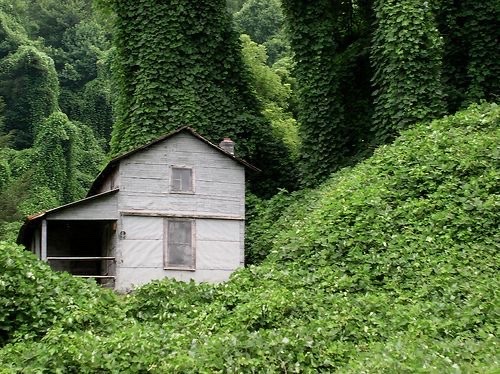#the vine that ate the south
Text
i wonder if people outside of the south really understand the scope of kudzu. it’s ubiquity, it’s constant presence, it’s almost comforting to see a gentle hill rolling green in the grasp of the vine because it feels like home. it blankets itself over the trees and the old power lines like a bedsheet ghost. but then you will see it eating its way mindlessly up the side of a mountain, and you’re filled with awe and terror at its empty power. it is a plant, it has no dreams of, no aspirations to conquest. but you see it climbing up the mountain, almost seeing it creep up to the sky moment to moment, and you know that left unchecked, this plant will destroy the world
#went up for some apples today and i got to thinkin#not me romanticizing the epitome of the invasive species as an abstraction of self-destruction!!#the vine that ate the south
18 notes
·
View notes
Photo

the destruction we left behind // emerald ash borer
#moodboard#aesthetic#green#white#yellow-green#monochrome#invertebrate#insect#bug#beetle#emerald ash borer#plant#nature#kudzu#the vine that ate the south#invasive species
3 notes
·
View notes
Text
The favourite author and his band are disappearing off the face of the Earth. He deleted his Patreon so I think the sequel to his first book has been cancelled or put on hiatus, and the website for the band is expired. At this point if anything more happens I will straight up release a zip of their discog and his book because if Th' Legendary Shack Shakers and The Vine that Ate the South by JD Wilkes aren't able to be preserved then I am going to die in real life.
#tlgtw reblog#the vine that ate the south#curse my hipster cred!#these damn artists should be less obscure then they'd be better preserved!!!
1 note
·
View note
Text
maybe if supernatural talked about the poetic nature of kudzu 🙄
2 notes
·
View notes
Text
Guys I’m trying to write an animated series pitch
Cryptid road trip or Southern Gothic Horror For Kids (but also absolutely terrifying like those scary stories to tell in the dark books I had as a kid)
#I still have them so the as a kid thing was slightly redundant#they made a great film adaptation of that#also read The Vine That Ate the South it’s a great piece of southern gothic and it got me into it
0 notes
Text
theres kudzu in my gaht damn yard trying to take over the crab apple tree and climb up on the roof. the thorns tear through my gardening gloves so i gotta get a heavy duty leather set cuz i am not letting that shit win!!!!!!!!!!
#mouses. spiders. kudzu. stinky oven. nicotine on the wood surfaces. everybody wanna be my enemy#the vine that ate the south the vine that can BITE MY ASS
1 note
·
View note
Text
A little post for any World's Beyond Number listeners who aren't familiar with kudzu.
Kudzu a vine from our world. It's known for being very invasive and for it's aggressive growth habits. It grows fast, dense, and climbs over everything, including trees. It looks like someone laid a green blanket over the landscape. It starves other flora of light. Smothered trees eventually die, leaving little more trace than the skeletal outline of a trunk. It is also difficult to fully eradicate and has a "nature will win in the end" apocalyptic vibe.



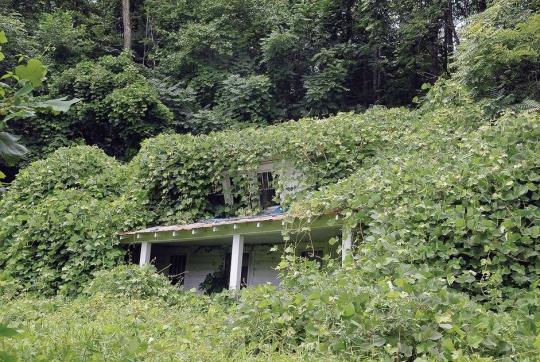

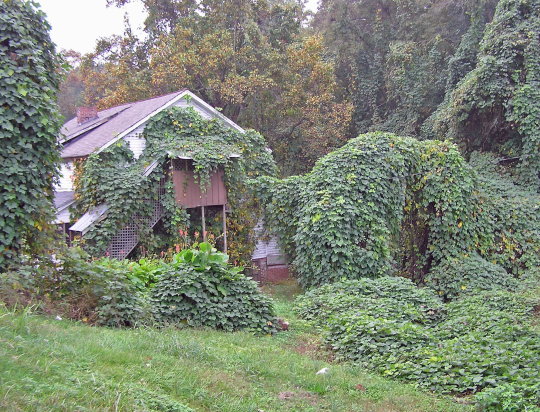

It's native to east/southern Asia but has established itself in many places. It's sometimes known as "the vine that ate the South" [southern United States]

371 notes
·
View notes
Note
What are your opinions on the invasive species of deciduous perennial vine called Kudzu?
What an interesting question to ask someone from the literal opposite end of the country from where it's invasive.
I've never even seen the stuff in real life, so I'm certainly not going expound on it like I'm an expert. I have read about it, and it seems like part of the problem is that it was intentionally planted by the millions as an attempt to control erosion. It's also a food to humans, goats, cows, and horses (and others, I'm sure). Here's an article about it that i for interesting when I read it a while ago:
I would encourage people who live near where it's a problem to learn how to forage and use it, because it sure seems like a tasty food plant.
16 notes
·
View notes
Text
Leafkit is born with kudzu around her throat.
It is, of course, her daemon, her heart-plant, the other half of her soul. It is a gift given to her by the very stars above, a blessing from Starclan, and it wraps tightly around her paws, and blooms across her back, and digs its roots in deeper, as she grows and loves and loses, again and again and again.
She's never been good and wanting only what Starclan wished for her.
that's right. warrior cat "daemon" au! it was a lot of fun to puzzle this one out, haha. i think it counts as a daemon au. mostly. sort of. look i consider it one and thats what is important.
its also a love letter to leafpool. but. it was always going to be, i think.
thanks to @mallowstep for posting about warrior cats and daemon aus, because without that the final pieces never would have clicked for me. <3
#warrior cats#leafpool#mothwing#squirrelflight#mothpool#daemons#daemon au#also do not ask how long i spend on plant websites okay#it was TOO LONG#worth it in the end yes but THERE ARE SO MANY PLANTS......#i write
25 notes
·
View notes
Text
山形県
Japanese Prefectures: Tohoku - Yamagata
都道府県 (とどうふけん) - Prefectures of Japan
Learning the kanji and a little bit about each of Japan’s 47 prefectures!
Kanji・漢字
山 やま、サン、セン mountain
形 かた、かたち、なり、ケイ、ギョウ shape, form
県 ケン prefecture
東北 とうほく north-east, Tohoku (northernmost six prefectures of Honshu)
Prefectural Capital (県庁所在地) : Yamagata (山形市)

Yamagata in southern Tohoku is known for natural beauty, impressive skiing, and hot springs. The prefecture is enclosed by the Sea of Japan to the west and mountains to the east, with port cities along the coast and secluded skiing and hot springs in the mountains. The mountain temple of Yamadera (or Risshakuji) was visited by the famous poet Basho and is the subject of one of the most famous haiku poems in Japan. The spectacular snow-covered trees in the mountainous areas are referred to as "snow monsters." The prefecture also produces 70% of Japan's cherries.
Recommended Tourist Spot・おすすめ観光スポット
Yamadera/Risshakuji - 山寺/立石寺
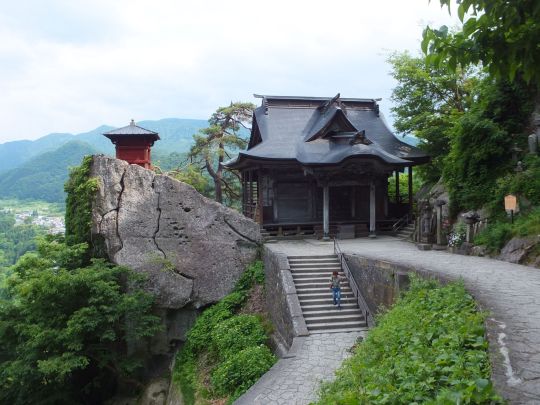
Photo by Tak1701d
Yamadera (also known as Risshakuji) is a scenic temple located in the mountains to the northeast of Yamagata City. The temple grounds extend high up a steep mountainside, from where there are great views down onto the valley. The temple was founded in 860 (during the Heian Period) as a temple of the Tendai sect under the official name Risshakuji. Its popular name, Yamadera, literally means "mountain temple." At the time of the founding, the area in Yamagata was at the northernmost national border.
Yamadera is also known for a visit in the late 1600s by the famous poet Basho, who composed one of his most famous haiku there. A statue of Basho and a rock inscription of his famous poem can be found in the lower area of the temple grounds. South of Yamadera and the train station there stands a museum dedicated to Basho that focuses on his trip to northern Japan. The main hall, Konponchudo Hall, is the oldest hall in the temple and houses a flame that is said to have been brought from Enryakuji in Kyoto and to have continued burning since the foundation of Yamadera.
A 30-minute hike up a stone path of 1000 steps that leads up the mountainside goes to the upper area of the temple grounds. There is a massive Mida Hora rock, shaped like Amida Buddha, at the top of the stone path, and past Niomon Gate is an open area with spectacular views into the valley. Past several of the temple buildings there are more stairs that lead up to the Godaido Hall, an observation deck with the best views onto the valley below. The building dates back to the early 1700s and extends out over the cliff.
Regional Cuisine - 郷土料理
Akebi (fruit of the Chocolate Vine) - アケビ(木通)

Philipp Franz von Siebold and Joseph Gerhard Zuccarini - Flora Japonica
The translucent white flesh with tiny black seeds inside of the akebi purple pod is eaten as fruit. It is relatively unknown that the purple pod can be cooked and eaten as well, but like a vegetable, not a fruit. Traditionally, akebi was viewed as a wild fruit that country kids plucked and ate from vines in Tohoku while playing in the mountains. As people became interested in discovering new and interesting culinary sensations, a variety of akebi that could be cultivated was developed about 20 years ago, centered in Yamagata prefecture. In Tohoku traditional akebi recipes did exist; the fruit was mixed with salt to pickle cucumber and was said to increase the sweetness (although akebi itself is not sweet), while the pod was stuffed, sauteed and deep fried.
In Akita Prefecture an herbal oil medicine was produced from the akebi seeds, but this is not a common practice. Interestingly, recent scientific research has shown the akebi to have antiseptic properties and to be a diuretic. Traditionally in Yamagata Prefecture, people believed that the spirits of ancestors returned to this world for Obon on a ship made of the akebi pod and offered akebi on the family Buddhist altar.
Akebi is in season for just two weeks or so in early autumn, and can be found in upscale grocery stores and specialty fruit boutiques. This makes it a rare delicacy.
Yamagata Dialect・Yamagata-ben・山形弁
Yamagata-ben, or the Yamagata dialect, is actually comprised of 4 different dialects, which are mostly comprehensible to their neighbors.
じぇじぇこほしい (jejeko hoshii)
Standard Japanese: お金が欲しい (okane ga hoshii)
English: I want money
めんこださげ、ける (men ko dasage, keru)
Standard Japanese: いい子だから、これあげる (ii ko dakara, kore ageru)
English: You're a good kid, so I'll give you this (present)
めーるさあがももつけておぐってみっか! (meeru sa agamomo tsukete ogutte mikka!)
Standard Japanese: メールにハートマークを付けて送ってみようか! (meeru ni haatomaaku wo tsukete okutte miyouka!)
English: I'm going to try adding a heart to this text and send it!
ほだなさすかえない (hadana sasu kaenai)
Standard Japanese: そんなの気にしなくていい (sonna no ki ni shinakute ii)
English: You don't have to worry about that
#japanese prefectures#日本語#japanese#japanese language#japanese langblr#langblr#studyblr#都道府県#山形県#yamagata
51 notes
·
View notes
Text
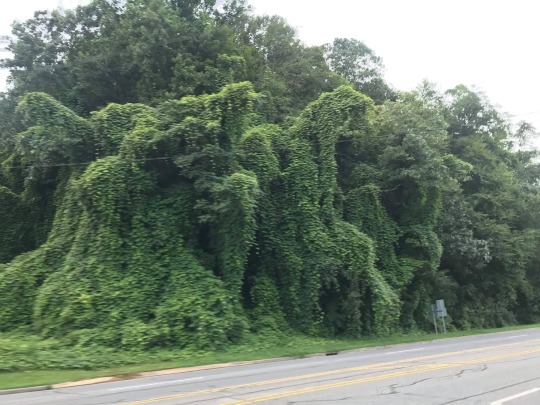


🌱 Kudzu Facts- Although it seems like an obvious fact now that kudzu is a nuisance, its fall from grace from ornamental plant to weed took nearly 100 years.
•Here are 15 things to know about kudzu:
1-Kudzu grows up to a foot per day. The rate of growth led to its nickname: "The Vine that Ate the South”.
2-Researchers have studied the possibility of using kudzu to make ethanol.
3-Farmers were paid to plant kudzu. In the 1930s, the government paid up to $8 an acre to plant kudzu, hoping to curb erosion
and add nitrogen to the soil.
4-Kudzu covers 7 million acres across the
southeastern U.S.
5-Kudzu can be useful. The sturdy vines are used to make baskets and artworks, and blossoms are used to make jelly.
6-All kudzu species are native to Asia. They come from the countries of Japan, China, India and Taiwan.
7-Kudzu was initially ornamental. By 1900, kudzu seeds were sold as an ornamental vine to shade porches and courtyards of Southern homes.
8-Kudzu came to the US in the 1800s.
Kudzu was shown at the 1876 Philadelphia Centennial Exposition, but those plants were destroyed. An 1883 exposition in New Orleans introduce the vine to the South. For many years, the fast-growing vine was widely marketed for use for shading porches, as food for cattle and a cover plant to prevent soil erosion.
9-It wasn't until 1970, when it had covered millions of acres of the country, mostly in Southern states, that the USDA declared kudzu a common weed, according to Claire Wilson of Auburn University. It was later listed as a "noxious" species.
10- Kudzu gets its name from a mistake.
The American word "kudzu" is a misspelling of the Japanese word for the plant, “kuzu”.
11- Kudzu is edible. Certain parts are, anyway, Leaves can be boiled, deep fried or eaten raw. Roots can be ground into flour or cooked like potatoes. Some people make jelly from the blossoms.
12- Kudzu is extremely bad for the ecosystems that it invades because it smothers other plants and trees under a blanket of leaves, hogging all the sunlight and keeping other species in its shade.
13- Without natural enemies in the region, it spreads at the rate of 150,000 acres each year, faster than it can be mowed or poisoned to control it.
14- Both cattle and goats will eat kudzu and will weaken and eventually control the plant.
15- There are at least 15 types of kudzu. The kudzu species we see in the south is one of the many species generally categorized as kudzu.
#appalachian#appalachian mountains#north carolina#appalachian culture#appalachia#western north carolina#the south#nc mountains#mcdowell county
16 notes
·
View notes
Text
Memories of the Upper Cathedral Ward would populate his nightmares, up until the day they followed him into one.
Looking back, he wished he had found nothing but death. He could still feel the damp cold of those stone floors creep all the way up to his spine. He could still smell the ever-present odor of brackish water, salt and rot mixed with formaldehyde and disinfectant. He still remembered how the hazy sweetness of Lumenflowers thickened the closer he moved towards faint whispers not quite muffled by strong walls and stronger doors.
He should have packed sedatives.
It's finally here! Cold enough to Crystallize, my story for @vermilionzines' For Whom the Bell Chimes - Bloodborne NPC zine!
This story is about Simon the Harrowed, and what turned a hunter of the Healing Church against said Church. I think it's because he found the same terrible things we did, and wanted to write about that.
Much thanks to the brilliant @rococospade-main for the invaluable help with this story, and even more for the friendship that came with it!
The first seeds of doubt, it seemed in retrospect, were sown by those who try to eradicate every last sprouting bud. The wild frenzy of conviction allows room only for the hardiest vines to grow, scarce and worn and tiny, but impossible to tear out once the first shadows take root within a foundation of cracked faith.
For Simon, it was hard to pinpoint when the cracks appeared in his belief in the Healing Church. Growing doubt ate away at the solid foundations of long-assumed truths, snaking through the mortar of reasonings he had repeated time and time again. By the time he conceded his heretical musings to himself, the roots of a million misgivings had already eroded the faith he had clung to beyond repair.
The Church — an older hunter, a clergyman, someone — had sent some of the Harrowed to the outskirts of the city, somewhere south of Hemwick, but still shadowed by the beautiful grand spires of Yharnam’s ecclesial weald. They were to spot and snuff out the first signs of the beastly plague that had taken too soon and too often, even among the ranks of the Church, turning into martyrs hunters and blood saints alike. While he often spent days in squalor posing as a beggar, Simon didn’t mind his duty. It bound him twofold to Yharnam and the Church: discovering early what threatened the lives of the city he treaded through like a ghost.
Except he did not find any signs of the scourge there.
He had returned to report as much, to the highest possible entity. The Vicar had been gentle. Understanding. Rueful, and pitying, and they might just as well have held a blade to Simon’s throat.
“Simon,” the Vicar had said, the glow of a hundred candles dancing on their face, “I take it you understand how valuable your work is to the Healing Church. To Yharnam.”
Simon could see fine silver-woven thread coming undone at the hem of their heavy clerical robes. The effigy of the First Vicar lay hidden in the darkness, as did the portraits of previous Church leaders, their long-dead eyes still piercing him like arrows.
“The city relies on us. And we rely on you. We cannot allow for… mistakes.” The Vicar had stepped very close now.
As they took Simon’s hand in theirs, he could feel how soft they were, the gentle touch of warmth sudden on his skin. Even without the light tricking his eyes, Simon recognized several blood gems on the rings adorning their hands that many hunters would — and had — died for. The Vicar’s eyes were clear as he met them, pupils crisp and dark and devoid of any sympathy. His throat went dry, as if the iron bite of hallowed blood mixed with the heavy scent of incense was getting to him.
“The last thing the Church — the last thing this city — needs is a repeat of the tragedy of Old Yharnam,” they said, tightening their grip on Simon’s hands. “Or an infection within our own ranks. Do you understand, Simon?”
Simon understood.
In his mind, festering doubt finally made itself known, breaking through his eroding mental walls like mold: Why would the Church harm their own?
Full story on AO3!
#Bloodborne#Simon the Harrowed#Bloodborne zine#For whom the bell chimes zine#From Software#Fromsoft games#soulsborne#gore#body horror#Healing Church#acid writing#my writing#bloodborne fanfiction
18 notes
·
View notes
Note
Ever take any plants that got you high? Lik the kind to make you see stuff?
Oh yeah. So the first time I was 21 and me Eddie and Felix were on shore leave in Trinidad. And there was this local girl who had the hots for Felix. You know how the girls get with sailors. They think we're real exotic they like hearing stories, so Felix put the moves on her because why the hell not? And so we got to drinking and she asked us if we'd ever tried anything harder. And then she passed out these mushrooms, I'd say they tasted like ass but that would be an insult to ass. But we ate em, and then we started seeing shit. I thought it was snowing, but it couldn't have been because like I said we were in Trinidad. Eddie swore my face was breaking out in hives but I didn't feel anything like that. Then I started seeing these swirling patterns on everything. And then the four of us got a little freaky and I'll spare you the details but let's just say you haven't had sex till you've had sex on shrooms.
Anyway Felix gave her the good head apparently, because she gave us some for the road, and on our way out of town we stole as many ceramic pots as we could carry, filled them up with dirt, and then we replanted the mushrooms she gave us in a back cell in the brig that Hornigold never used and me, Eddie and Felix, until he died, then it was just me and Eddie, grew those things for a year before Hornigold caught us.
Much more recently me and Anne and Mary ran our ship aground on the Pacific side, somewhere south of Panama, and we had to fend for ourselves for food for a couple of days. And we saw some animal gnawing on this big old vine, so we figured it was probably edible. In hindsight a jungle cat eating a plant is probably a red flag but we were hungry. And it was edible, but the whole world started moving in waves and Mary's eyes started bugging out of her head. Later we met some of the locals and they made fun of us for not knowing the vine in question would make you trip balls before helping us push our boat out to sea.
2 notes
·
View notes
Text
today in the "our lights in ashes lecture series", also known as "posts absolutely no one asked for": plants!
everything's blooming around me right now so I gotta. to me, setting is key and I have to believe in the place I'm reading or writing about. including local flora makes it feel distinct to me, and was the kind of thing I hoped contributed to making the setting come alive even if you don't know the area or the plants that come up
from chapter 1: They paced through the woods in sight of each other, moving in tandem while covering a wider swathe. Jack appeared in steady flashes between trees, shoes pressing down pine needles and packed dirt. The thick canopy lent the forest a purple gloom, while clusters of pipsissewa and ginseng dotted the lower brush with colour. The green of every leaf deepened as they traversed further into the woods.

these first two examples aren't heavy on symbolism, but they're pretty. and woods aren't only about trees. the lush undergrowth of a Virginia forest with ferns and flowers add such depth.
from chapter 3: One moment they drove through a low-country landscape of oatmeal-brown marsh grass, then they crossed the bridge and a city rose with its handsome old buildings and lush greenery like the Hanging Gardens of Babylon. Jack looked around with new eyes, taking in a city that entirely lacked the usual commotion and buzz. Shaded streets lined with Southern live oak, their dark reaching branches hanging with Spanish moss.
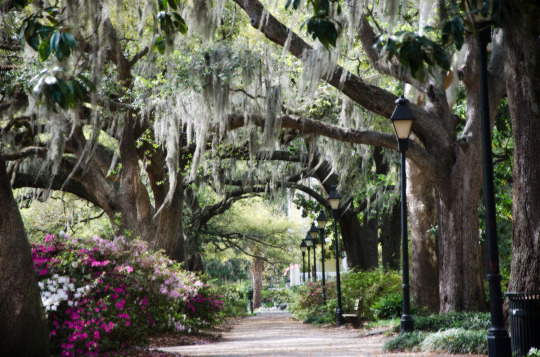
Southern live oak and Spanish moss! oh boy, you know you're in the South when. it's the way the live oak reaches out and the moss drapes over the branches like a ghost. it lends such a colour to the very atmosphere, this ancient and mysterious green-grey.
from chapter 5: They reached the gulch where the bodies had been found. The whole area crawled with kudzu, enshrouding the trees and the forest floor in vibrant green. An abandoned truck and an even older car had been lost to the gulch in ages past, and now the kudzu threatened to swallow them entire.

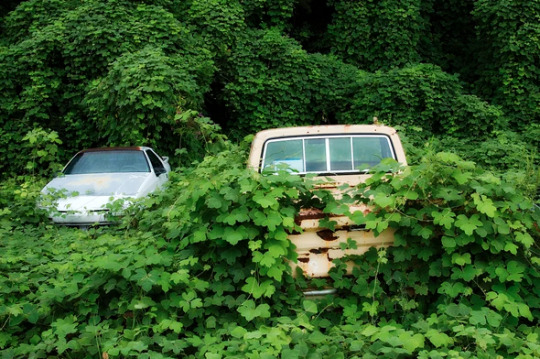
okay, now we're in to some more overt symbolism. kudzu, an invasive species, is known as "the vine that ate the South." it's fast-growing and can easily choke out other plants and block their access to resources. this is in a chapter about explicit prejudice and hatred, which endangers diversity and under which none of us can flourish. hatred is a poison and the rise of alt-right extremism concerns me. you want to see what will devour our society? kudzu doesn't seem so bad.
from chapter 6: The twins lived in the bayou, in a white, two-story house with a small porch that had the swing and another balcony on the floor above it. Tall trees shaded it all through the day, and azaleas grew abundantly around the porch steps.

so I'm very fond of azaleas. this was one of the flowers that had more traditional symbolism attached: they are seen to represent familial duty and homesickness, as well as wealth and elegance. this was a great fit for our semi-disinherited twins, Emory and Sawyer. they are also poisonous, which I like for representing the dark and dangerous strain of their familial past. the azaleas represent the way they are still attached to their mother despite everything, and the fact they bother to care for these flowers is a small nod to Mona's far more extensive garden in the next chapter.
from chapter 7: He eventually took a seat within a tiny enclosed arbor, where vines and flowers crawled over the surrounding latticework. A honeybee joined him, investigating the purple beautyberry and blazing star, carving a path through the world that told a story to anyone paying attention.

purple is frequently associated with witchcraft in spn, so I couldn't resist mentioning purple flowers in Mona's garden as a way to code her as magic. as it happens, bees also tend to love purple flowers so Cas isn't complaining. oh, and blazing star is sometimes also called "gayfeather" so there's something in that about gay angels because I'm very mature, I guess.
chapter 7: Golden afternoon light shone in shards through the leaves and boughs of the old magnolia trees, glinting in the glimpses of sky between grey tendrils of swaying Spanish moss.
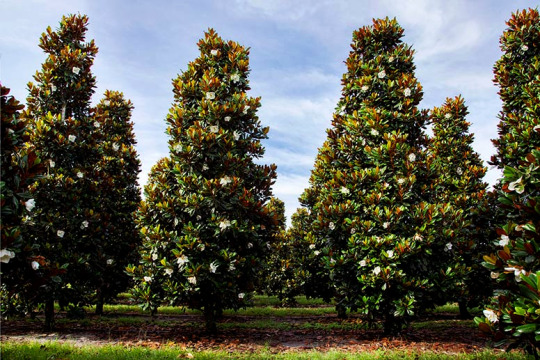
it just wouldn't be the South if there weren't magnolias. they wouldn't have been in bloom at the time that Dean and Cas are at Mona's, so I did not get to lean into the lovely scent as much as one would like. actually, I tried to be careful with what would theoretically be in bloom or berrying in autumn, when the story takes place. however anyone who knows more about plants must excuse if I stretched seasons too far, writers will absolutely push the limits for the sake of a story.
from chapter 8: He found the swinging sign of the Brass Lantern Inn, surrounded by feathery pink muhly grass.

look at this stuff. it's so dreamy. wispy as pink mist, then catching the light to look like tiny fireworks. the final chapter of our lights in ashes is all about dusk and dawn and is tinted with the colours of sunrise reflecting through the water, gold and pink and orange. (in the first chapter, the hope of daybreak doesn't save a boy from his fate. in the final chapter, daybreak fulfills its promise.) and there may not be fireworks for the Big Damn Kiss at the end, but maybe we got near enough.
#our lights in ashes#writing inspiration#works cited#flowers#southern gardens#southern gothic#THIS HAS BEEN A POST#like I don't even know who the target audience is for this#just me putting off other things I should be doing#our lights in ashes lecture series
14 notes
·
View notes
Text

WHEN VEGGIES ATTACK!
Kudzu is a plant native to Japan and southeast China. Introduced to North America in the 19th century, and has been nicknamed the "Vine that Ate the South." This abandoned house in Helen, Georgia, has been almost completely overtaken by kudzu.
2 notes
·
View notes
